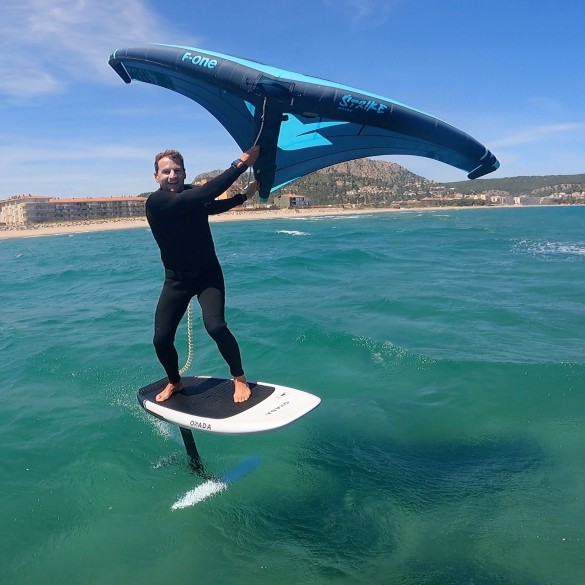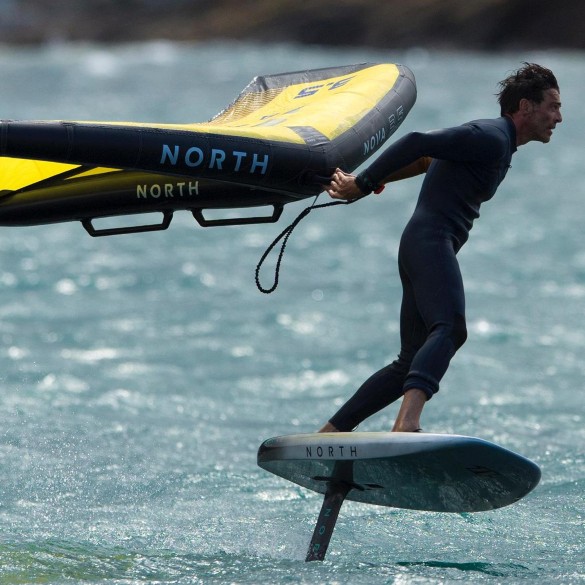Mastering heelside and toeside riding in wing foiling: Embracing the balance of dynamic manoeuvres
Wing foiling is a thrilling blend of windsurfing and kiteboarding and has rapidly gained popularity among water sports enthusiasts worldwide. As riders take flight on their foil boards, they must navigate the art of riding heelside and toeside, two fundamental riding styles that unlock a world of possibilities on the water. Each style offers unique challenges and advantages, and becoming proficient in both is essential for a well-rounded and exhilarating wingfoiling experience. In this wing foiling tutorial we go into the aspects of heelside and toeside riding: what it brings to you and why you should learn both. See all wingfoil tutorials here.



Riding heelside
Heelside riding involves positioning yourself with your back facing the wind while using your heels to control the direction of the foil board. This riding style is often the starting point for beginners, as it provides increased stability and control. By facing the wind, riders can use the wing’s power more efficiently, maintaining a consistent and balanced glide. The heelside stance also offers a more stable platform for learning the basics of wingfoiling, including steering, managing speed, and making smooth turns.
In heelside riding, your body weight is distributed evenly across both feet, allowing you to maintain stability and resist the forces of the wind and water. This riding position is particularly beneficial when navigating choppy waters or gusty wind conditions, as it helps riders maintain control and stay upright.
One of the key benefits of heelside riding is the ability to perform smooth and controlled carving turns. By leaning into the heels, wingfoilers can initiate turns with ease, gracefully gliding from one direction to another. This manoeuvrability is invaluable when exploring flatwater locations or cruising along the shoreline, enhancing the overall joy of wingfoiling. It’s step one in learning heelside and toeside riding.


Riding toeside
Toeside riding, on the other hand, involves facing the front of the board and steering with your toes. This riding position allows for a more agile and dynamic riding experience. While toeside riding offers enhanced maneuverability, it also requires a higher level of balance and body awareness, making it a more advanced skill to master.
In toeside riding, the rider faces against the wind, which requires better wing control and balance. To maintain stability, wingfoilers shift their weight to the front foot, engaging the toes to control the foil’s direction. Executing toeside turns demands precision and finesse, but it grants riders the ability to pivot quickly, navigate waves, and take on more challenging conditions.
As wingfoilers progress in their riding journey, learning to ride toeside opens up a world of wave riding possibilities. Riding toeside allows for tighter and more responsive turns, ideal for catching and carving through waves. It enables riders to embrace the thrill of wave riding, tapping into the natural energy of the ocean and experiencing the exhilaration of carving and surfing on the foil board. It’s also very handy to learn how to jibe if you already know how to ride both sides.

Toeside riding allows for a quick jibe (to the left on this photo) without having to switch feet during or after the jibe.
It does take time and effort to learn how to ride toeside, but it will pay off in ability to turn and be versatile.
Riding heelside and toeside: conclusions
Mastering both heelside and toeside riding is crucial for a well-rounded wingfoiling skill set. By being proficient in both styles, wingfoilers can adapt to various wind and water conditions, maximising their time on the water and unlocking new riding experiences.
To achieve balance and harmony in wingfoiling, riders should practice riding heelside and toeside on both tacks (right and left). Regular practice will enhance muscle memory and body awareness, making it easier to switch between riding styles seamlessly. Developing this versatility not only expands your wingfoiling repertoire but also boosts confidence and enjoyment in the sport.
In conclusion, the art of riding heelside and toeside in wing foiling is a dynamic dance between stability and agility. Heelside riding offers the foundation of control and stability, perfect for beginners and navigating challenging conditions. Toeside riding, on the other hand, unlocks the thrill of agility and wave riding, providing a more advanced level of maneuverability and responsiveness. By embracing both riding styles, wing foilers can truly embrace the exhilaration and freedom of wingfoiling, gliding gracefully on the water’s surface and soaring with the wind’s embrace.
Other interestsing tutorials:
- Learning to take off
- Maintaining longer flights
- How to get into the water safely
- Wingfoil safety tips
Photo credits: Miquel & Albert
